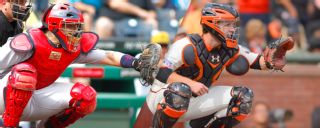|
One of the recent developments in baseball's statistical evolution is the emphasis on catchers who are good at getting called strikes for their pitchers (known within the game as pitch framing). Albert Larcada of TruMedia Networks developed a tool and set of statistics that allow us to take a closer look at individual performance. As a means of introducing the tool and getting familiar with it, let’s look at the early returns for two veteran catchers: Yadier Molina and Buster Posey. Molina looking like his old self
From 2009 to 2013, Molina excelled at getting called strikes for his pitchers.
One of the metrics TruMedia developed looks at how many strikes a catcher got versus how many an average catcher would have gotten, based on the average chance of each pitch being called a strike. We refer to this as “strikes looking above average.” As the chart on the right shows, over that five-year span, Molina was among the best at this, getting extra strikes at a rate of a little more than one per game, over an average of 135 games per season. Those numbers dipped the last two seasons as Molina aged and battled injuries. But in 2016, Molina is off to a great start in that stat, with 28.6 extra strikes in 15 games, which was the most of anyone entering Thursday. We can show where Molina is getting the extra strike calls using a heat map. This image shows Molina’s rate of getting called strikes this season. Red patches indicate spots he’s getting calls at a rate 15 percent or better above the league average. Blue spots show areas in which he’s getting calls at a rate 15 percent below. Green shading shows everything in between.  Molina’s “hot spots” are the inside corner against left-handed hitters and especially the outside corner against right-handed hitters. Molina’s “hot spots” are the inside corner against left-handed hitters and especially the outside corner against right-handed hitters.
But one thing to learn is that much like with hitting and pitching performance, small sample sizes can over or under-exaggerate. In Molina’s case, he got 20.7 of those 28.6 extra strikes in the first three games of the season against the Pittsburgh Pirates (whether he had three good days or there were other factors involved isn't necessarily easy to tell). Here’s Molina’s heat map over his last 12 games, in which his numbers look good (eight strikes above average), and he’s still getting calls on the corners, though not to the same extreme.  So our conclusion to this point would be that Molina is off to a good start, though not necessarily as good as the numbers indicate. So our conclusion to this point would be that Molina is off to a good start, though not necessarily as good as the numbers indicate.
Posey: not off to a great start
Last year, FiveThirtyEight's Rob Arthur wrote a piece titled “Buster Posey’s Pitch Framing Makes Him a Potential MVP,” showing how he was elite in that regard. Posey ranked fourth in the majors in strikes looking above average last season. The numbers have not been as kind to Posey in 2016. He ranks 40th, at -6.85 strikes looking below average. Here are his heat maps.  But much like Molina, Posey’s statistical struggle is rooted in the opening series of the season, when he was two strikes looking below average in three straight games (he totaled 10 such games in 2015). You might recall that a flu bug infiltrated the Giants’ clubhouse that week, so maybe Posey was a bit under the weather (or perhaps he just had a bad start, breaking in a couple of new pitchers in Jeff Samardzija and Johnny Cueto). But much like Molina, Posey’s statistical struggle is rooted in the opening series of the season, when he was two strikes looking below average in three straight games (he totaled 10 such games in 2015). You might recall that a flu bug infiltrated the Giants’ clubhouse that week, so maybe Posey was a bit under the weather (or perhaps he just had a bad start, breaking in a couple of new pitchers in Jeff Samardzija and Johnny Cueto).
Since the first three games, Posey has rated about major league average. Last season, he had 44 games in which he notched at least two strikes looking above average. He got his first this season catching Madison Bumgarner ’s start against the Arizona Diamondbacks on Wednesday. In that game, he got called strikes on five pitches that had a 25 percent chance or less of being called a strike (relatively speaking, a high total). All five were pitches just off the outside corner to right-handed hitters. He also got strike calls on every pitch with a strike probability of 75 percent or higher. That’s the Posey whose catcher framing earned MVP plaudits. So even though these numbers tend to establish themselves quickly (based on research reflected in this Baseball Prospectus article), maybe Posey will turn out to be just fine after all. Much like with most stats this season, we’re going to have to wait and see.
|

